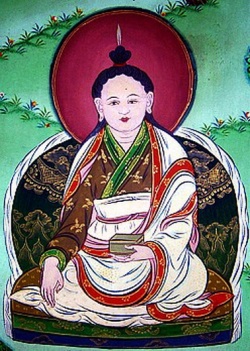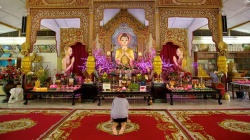Difference between revisions of "Künzang Gongpa Zangthal"
| Line 7: | Line 7: | ||
[[Rigzin Gödem]] was the [[re-incarnation]] of [[Nanam Dorje Düdjom]], one of the closest [[disciples]] of [[Padmasambhava]]. He was born in 1337 in a family renowned for holding profound [[Vajrakilaya]] [[transmissions]]. In accordance with a {{Wiki|prophecy}}, when he was young five protuberances looking like [[vulture]] feathers grew on his head. He thus became famous as [[Rigzin Gödem]]—the [[Vidyadhara]] with [[Vulture feathers]] on his head. Before departing [[Tibet]], [[Padmasambhava]] placed a number of texts and various [[sacred]] [[objects]] in a maroon leather casket and concealed them in a {{Wiki|cave}} called [[Zangzang Lhadrak]]. | [[Rigzin Gödem]] was the [[re-incarnation]] of [[Nanam Dorje Düdjom]], one of the closest [[disciples]] of [[Padmasambhava]]. He was born in 1337 in a family renowned for holding profound [[Vajrakilaya]] [[transmissions]]. In accordance with a {{Wiki|prophecy}}, when he was young five protuberances looking like [[vulture]] feathers grew on his head. He thus became famous as [[Rigzin Gödem]]—the [[Vidyadhara]] with [[Vulture feathers]] on his head. Before departing [[Tibet]], [[Padmasambhava]] placed a number of texts and various [[sacred]] [[objects]] in a maroon leather casket and concealed them in a {{Wiki|cave}} called [[Zangzang Lhadrak]]. | ||
| − | These were the [[Northern treasures]]. In 1366, [[Vidyadhara Gödem]] took the casket out of the {{Wiki|cave}} of [[Zangzang Lhadrak]]. The casket had five containers made of various [[precious]] materials and each one in a different {{Wiki|color}}. These five containers with their contents later became known within the [[lineage]] as the [[Dzö Nga]] ([[mdzod lnga]]) or [[Five Treasuries]]. The central container was deep red and of leather. The eastern container was white and made of [[conch shell]]. The southern container was golden and made of {{Wiki|gold}}. The {{Wiki|western}} container was red and of {{Wiki|copper}}. The northern container was black and made of {{Wiki|iron}}. These texts covered a great variety of topics: [[prayers]] such as [[Le'u Dünma]] ([[Prayer in Seven Chapters]]), [[sadhanas]] such as [[Jangter Kagyed]], [[rituals]], [[Dzogchen]] instructions and so on. [[Vidyadhara Gödem]] decoded the texts, had them transcribed, and then transmitted them to [[worthy]] students. Soon the teachings of the [[Northern Treasures]] spread to all regions of [[Tibet]]. | + | These were the [[Northern treasures]]. In 1366, [[Vidyadhara]] [[Gödem]] took the casket out of the {{Wiki|cave}} of [[Zangzang Lhadrak]]. The casket had five containers made of various [[precious]] materials and each one in a different {{Wiki|color}}. These five containers with their contents later became known within the [[lineage]] as the [[Dzö Nga]] ([[mdzod lnga]]) or [[Five Treasuries]]. The central container was deep red and of leather. The eastern container was white and made of [[conch shell]]. The southern container was golden and made of {{Wiki|gold}}. The {{Wiki|western}} container was red and of {{Wiki|copper}}. The northern container was black and made of {{Wiki|iron}}. These texts covered a great variety of topics: [[prayers]] such as [[Le'u Dünma]] ([[Prayer in Seven Chapters]]), [[sadhanas]] such as [[Jangter Kagyed]], [[rituals]], [[Dzogchen]] instructions and so on. [[Vidyadhara Gödem]] decoded the texts, had them transcribed, and then transmitted them to [[worthy]] students. Soon the teachings of the [[Northern Treasures]] spread to all regions of [[Tibet]]. |
The most remarkable feature of the [[Northern Treasures]] [[transmissions]], the most famous and the most highly praised, is its [[Dzogchen]] section. It is within this section that the great collection of [[Dzogchen]] instructions known as [[Künzang Gongpa Zangthal]] is found. It is a complete system of teachings covering all aspects of [[Mahasandhi]], from the first introductory levels to the [[highest]] [[secret instructions]] of [[thögal]]. Praised by many [[masters]] for its profundity and clarity, it has been the source of the [[highest]] [[realization]] for countless practitioners. It is in fact considered as one of the three supreme [[transmissions]] of [[Dzogchen]], together with [[Nyingthig Yabzhi]] of [[Longchenpa]] and [[Ati Zabdön Nyingpo]] of [[Terdag Lingpa]]. It is said that the bare fact of receiving the [[empowerment]] of [[Künzang Gongpa Zhangthal]] closes forever the door to the lower states of [[existence]] and is the unerring source of [[boundless]] [[benefit]]. | The most remarkable feature of the [[Northern Treasures]] [[transmissions]], the most famous and the most highly praised, is its [[Dzogchen]] section. It is within this section that the great collection of [[Dzogchen]] instructions known as [[Künzang Gongpa Zangthal]] is found. It is a complete system of teachings covering all aspects of [[Mahasandhi]], from the first introductory levels to the [[highest]] [[secret instructions]] of [[thögal]]. Praised by many [[masters]] for its profundity and clarity, it has been the source of the [[highest]] [[realization]] for countless practitioners. It is in fact considered as one of the three supreme [[transmissions]] of [[Dzogchen]], together with [[Nyingthig Yabzhi]] of [[Longchenpa]] and [[Ati Zabdön Nyingpo]] of [[Terdag Lingpa]]. It is said that the bare fact of receiving the [[empowerment]] of [[Künzang Gongpa Zhangthal]] closes forever the door to the lower states of [[existence]] and is the unerring source of [[boundless]] [[benefit]]. | ||
Revision as of 21:46, 13 April 2014
Künzang Gongpa Zangthal (kun bzang dgongs pa zang thal) is the highest Dzogchen teachings of the Northern Treasures tradition. Gongpa Zangthal is in five volumes and was concealed by Guru Rinpoche and later revealed by Rigzin Gödem (1337-1408), the master who founded the Jangter (Northern Treasures) tradition of the Nyingma school. Künzang Gongpa Zangthal meaning 'Showing Directly the Realization of Samantabhadra' also contains the renowned 'Aspiration of Samantabhadra.' Often referred to as Gongpa Zangthal (Unimpeded Realization), these teachings are said to be the heart teachings of Guru Padmasambhava. Gongpa Zangthal is renowned as one of the most sublime works on Dzogpa Chenpo among Padmasambhava’s vast body of teachings. Dudjom Rinpoche wrote in his History of the Nyingma School that the Northern Treasures were bestowed to help the king and his descendents but they subsequently served all Tibetans like a faithful minister.
The three foremost tertöns (treasure revealers) of Tibet who were the supreme body, speech and mind emanations of Guru Rinpoche himself were Nyang Rel Nyima Özer (body emanation), Guru Chökyi Wangchuk (speech emanation) and Rigzin Gödem (mind emanation). The treasures discovered by Nyang Rel Nyima Özer and Guru Chöwang and the lineages that arose from them came to be known as Lhoter or the Southern Treasures since they were discovered south of the Tsangpo river. The treasures discovered by Rigzin Gödem and the lineage that arose from them are called Jangter or the Northern Treasures since they were discovered north of the Tsangpo river.
Rigzin Gödem was the re-incarnation of Nanam Dorje Düdjom, one of the closest disciples of Padmasambhava. He was born in 1337 in a family renowned for holding profound Vajrakilaya transmissions. In accordance with a prophecy, when he was young five protuberances looking like vulture feathers grew on his head. He thus became famous as Rigzin Gödem—the Vidyadhara with Vulture feathers on his head. Before departing Tibet, Padmasambhava placed a number of texts and various sacred objects in a maroon leather casket and concealed them in a cave called Zangzang Lhadrak.
These were the Northern treasures. In 1366, Vidyadhara Gödem took the casket out of the cave of Zangzang Lhadrak. The casket had five containers made of various precious materials and each one in a different color. These five containers with their contents later became known within the lineage as the Dzö Nga (mdzod lnga) or Five Treasuries. The central container was deep red and of leather. The eastern container was white and made of conch shell. The southern container was golden and made of gold. The western container was red and of copper. The northern container was black and made of iron. These texts covered a great variety of topics: prayers such as Le'u Dünma (Prayer in Seven Chapters), sadhanas such as Jangter Kagyed, rituals, Dzogchen instructions and so on. Vidyadhara Gödem decoded the texts, had them transcribed, and then transmitted them to worthy students. Soon the teachings of the Northern Treasures spread to all regions of Tibet.
The most remarkable feature of the Northern Treasures transmissions, the most famous and the most highly praised, is its Dzogchen section. It is within this section that the great collection of Dzogchen instructions known as Künzang Gongpa Zangthal is found. It is a complete system of teachings covering all aspects of Mahasandhi, from the first introductory levels to the highest secret instructions of thögal. Praised by many masters for its profundity and clarity, it has been the source of the highest realization for countless practitioners. It is in fact considered as one of the three supreme transmissions of Dzogchen, together with Nyingthig Yabzhi of Longchenpa and Ati Zabdön Nyingpo of Terdag Lingpa. It is said that the bare fact of receiving the empowerment of Künzang Gongpa Zhangthal closes forever the door to the lower states of existence and is the unerring source of boundless benefit.
The third incarnation of Rigzin Gödem, Ngagi Wangpo (1580-1639), established the great Monastery of Dorje Drak in Central Tibet, which quickly became renowned as one of the most important centers of study and practice of the Nyingma School. This Dorje Drak tradition of the Northern Treasures has been transmitted uninterruptedly up to the present day and today Kyabje Taklung Tsetrul Rinpoche is its most revered lineage holder and one of the senior most living masters within the Nyingma School of Tibetan Buddhism. Kyabje Rinpoche bestowed the entire Kama transmissions (Oral Transmissions Lineage) in the Mindrolling Monastery to a vast assembly in 1997. Kyabje Taklung Tsetrul Rinpoche then transmitted the entire Rinchen Terdzöd to thousands of tulkus, khenpos, monks, nuns and practitioners in 2008-2009. It was an historic and most marvelous event benefitting countless sentient beings. We hope and pray that the Künzang Gongpa Zangthal transmissions will also bring similar blessings and benefit to the entire Buddhist world.

